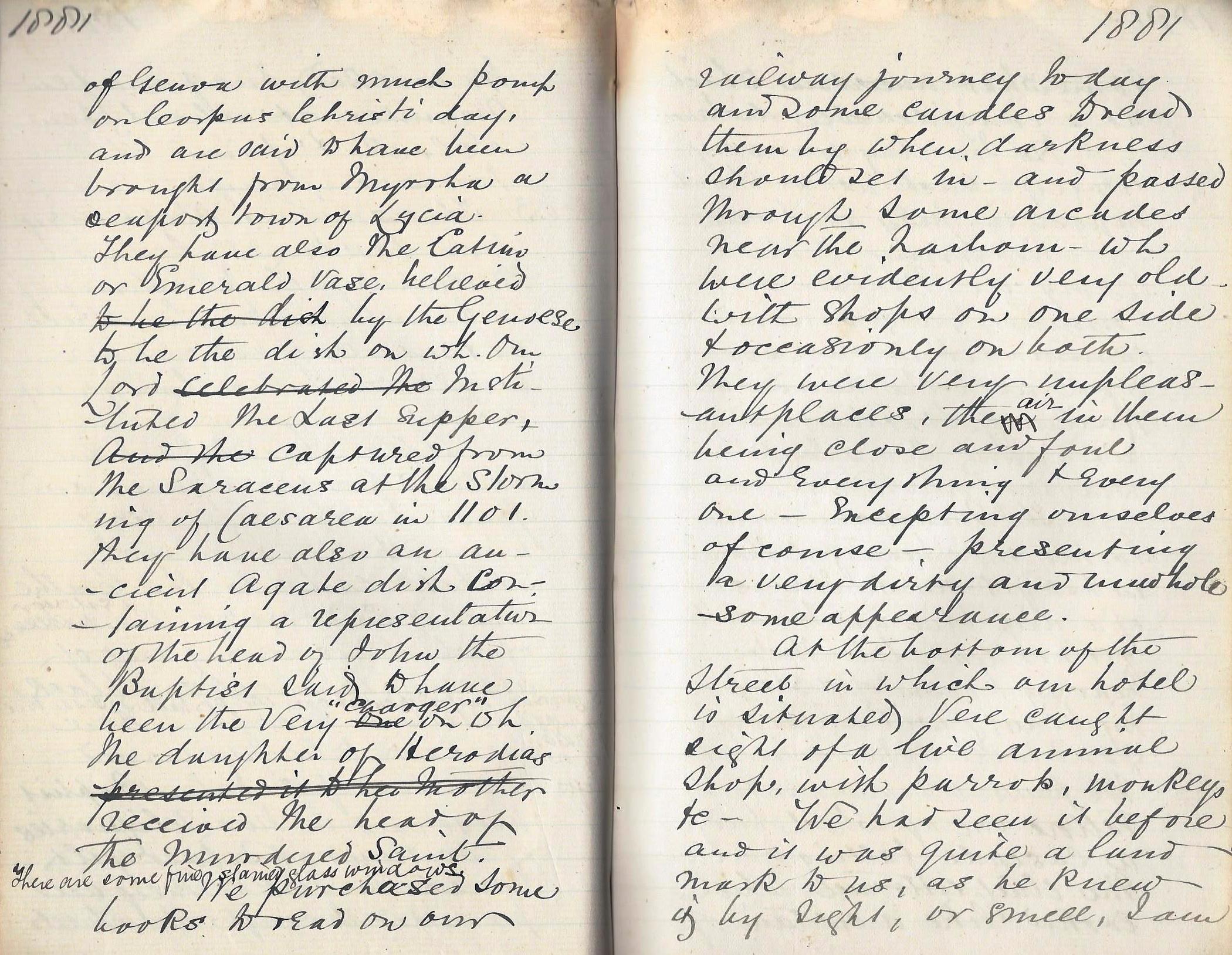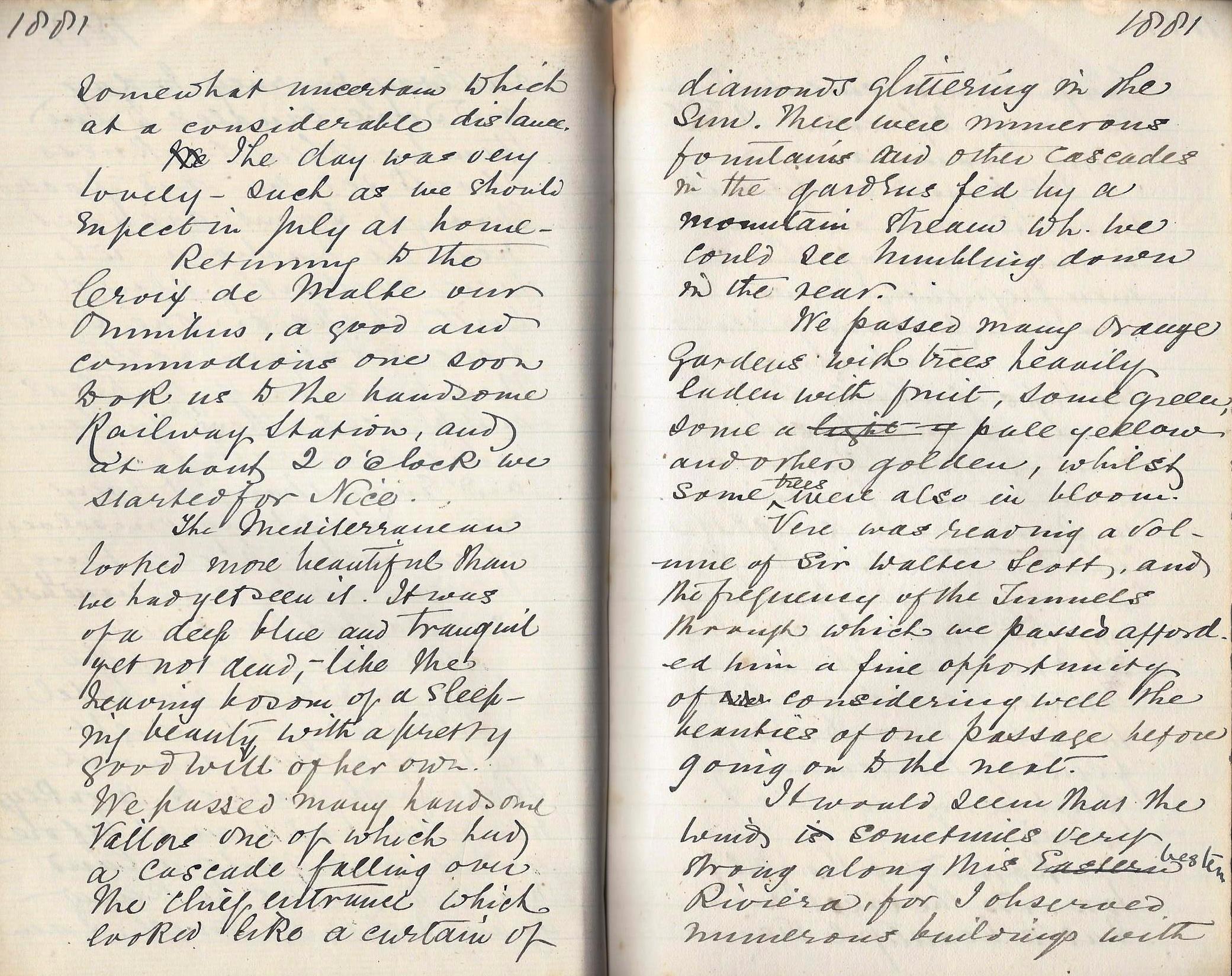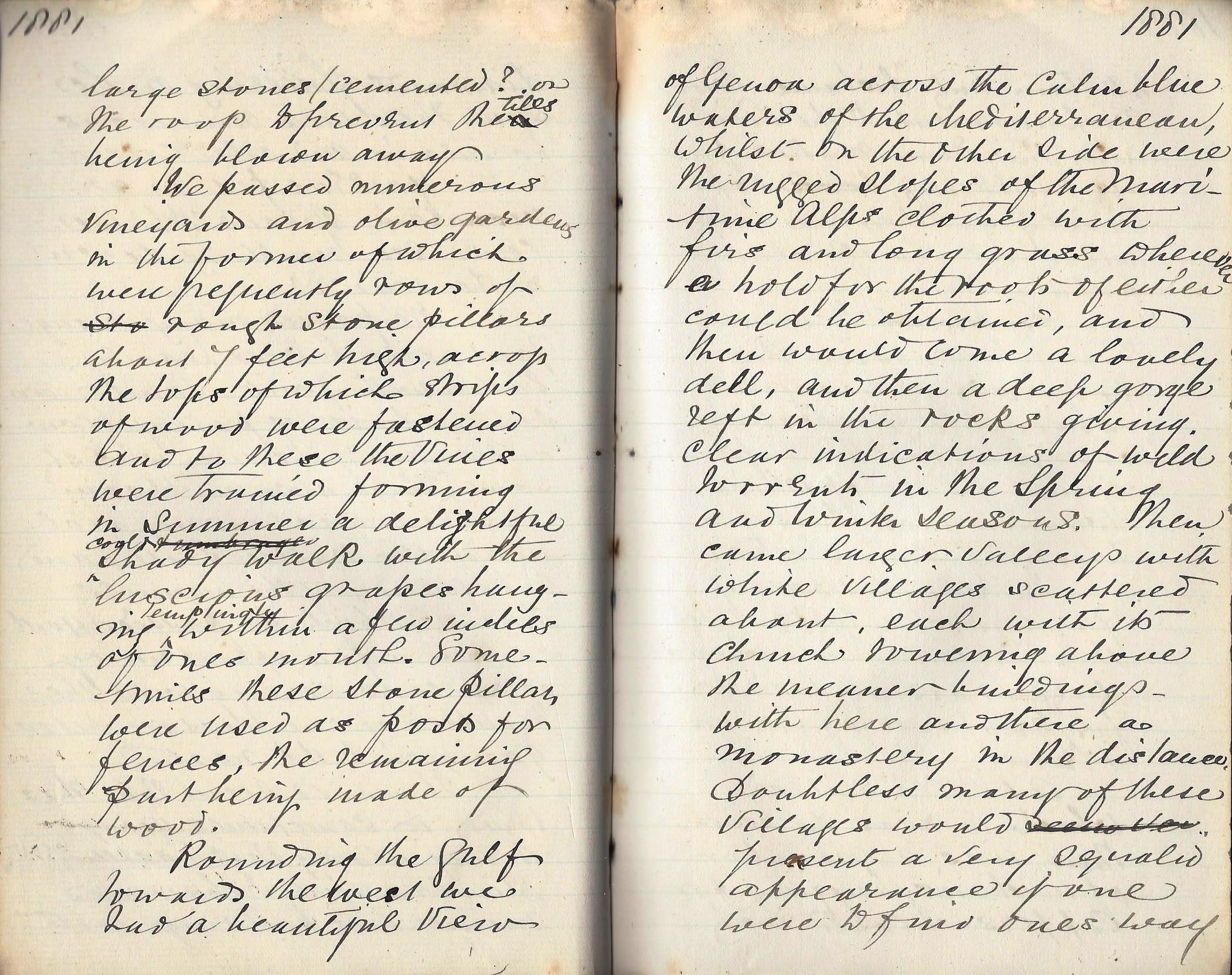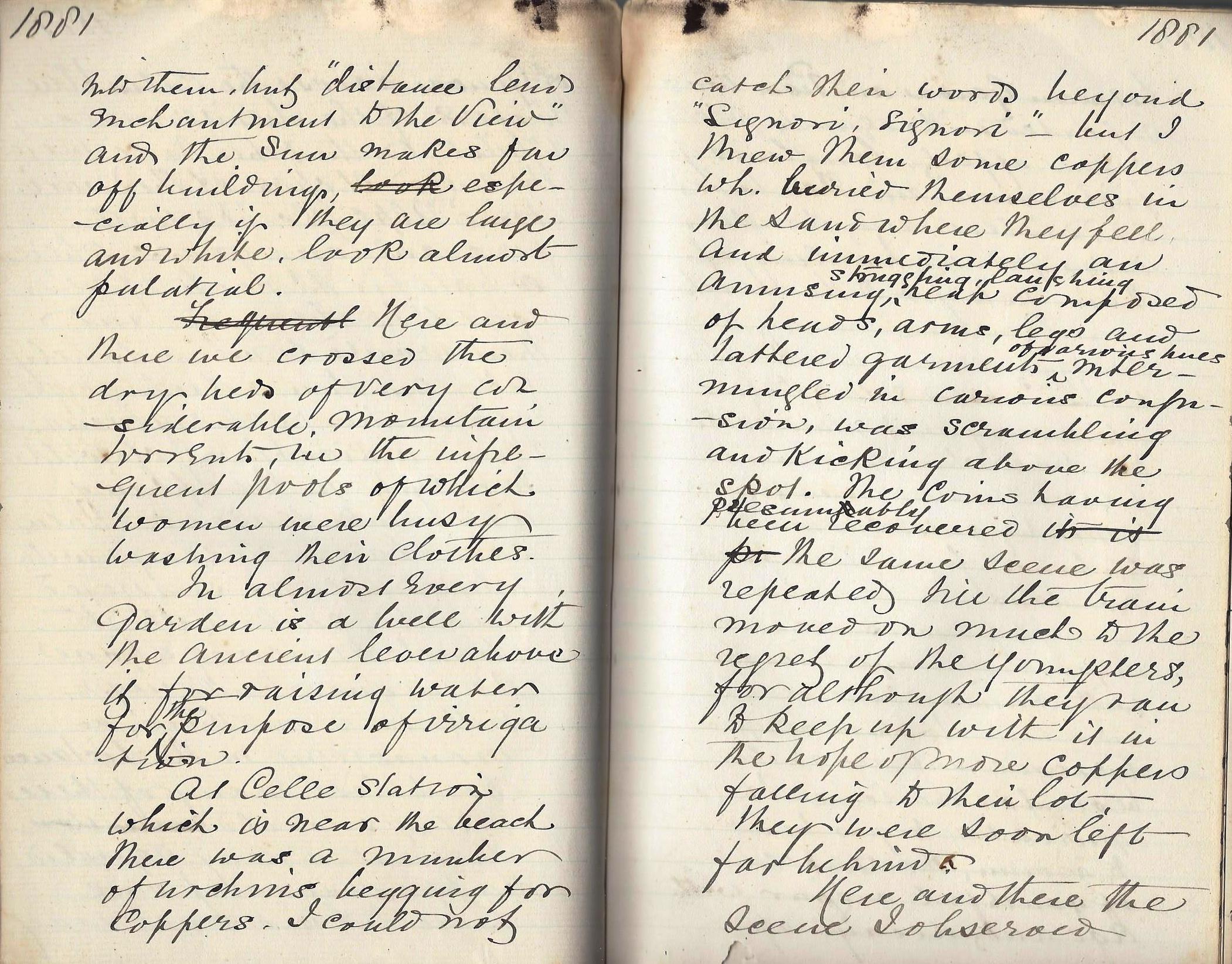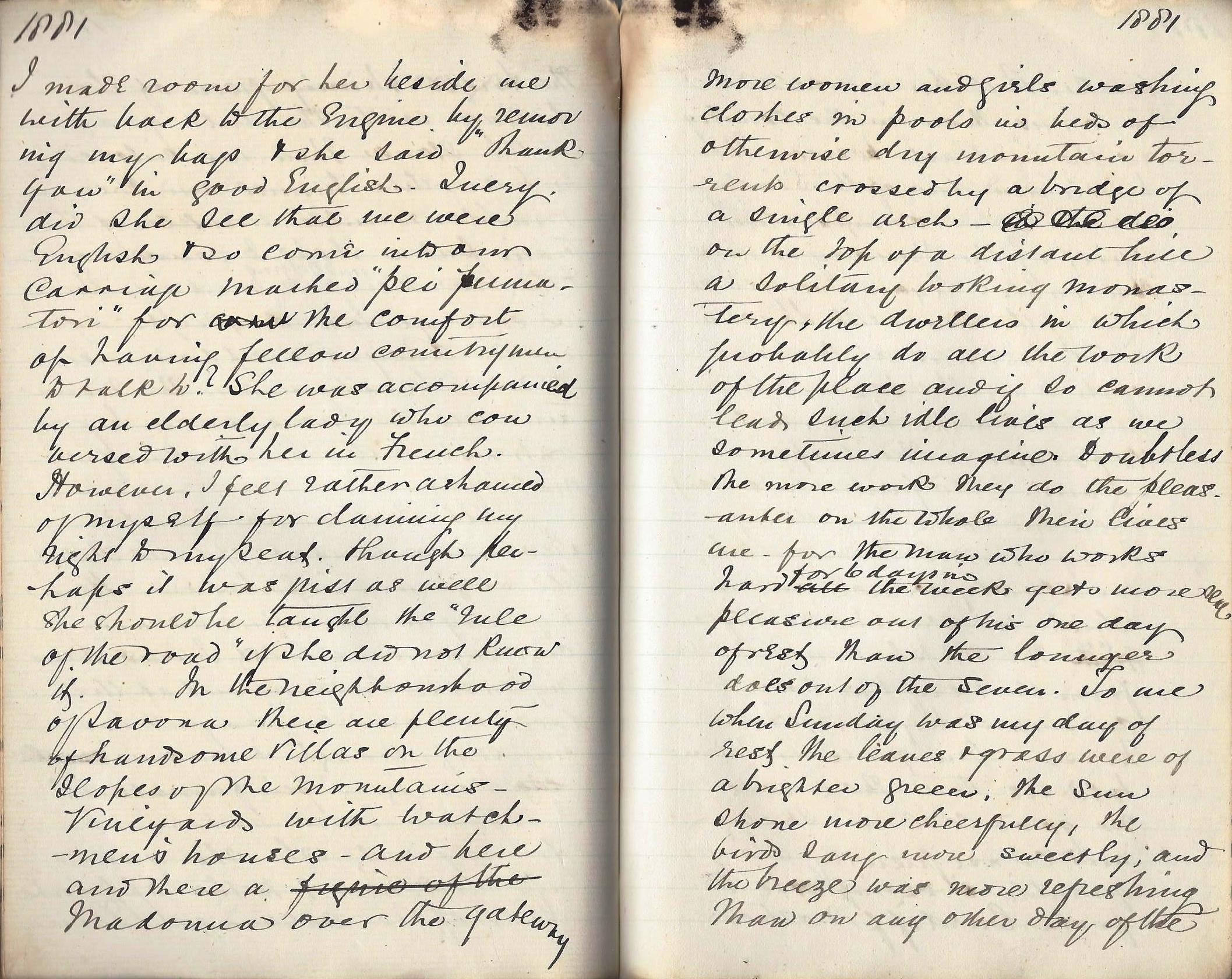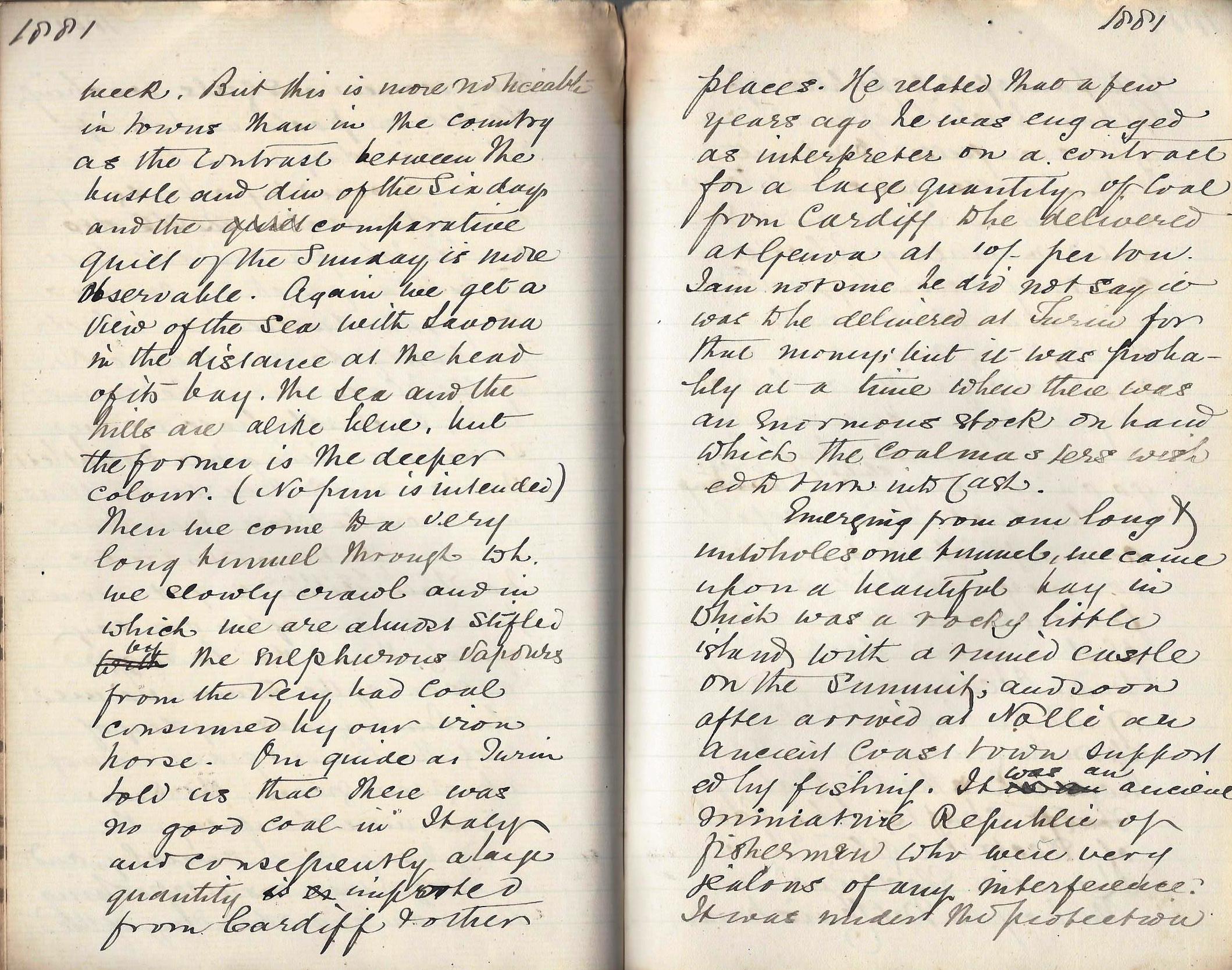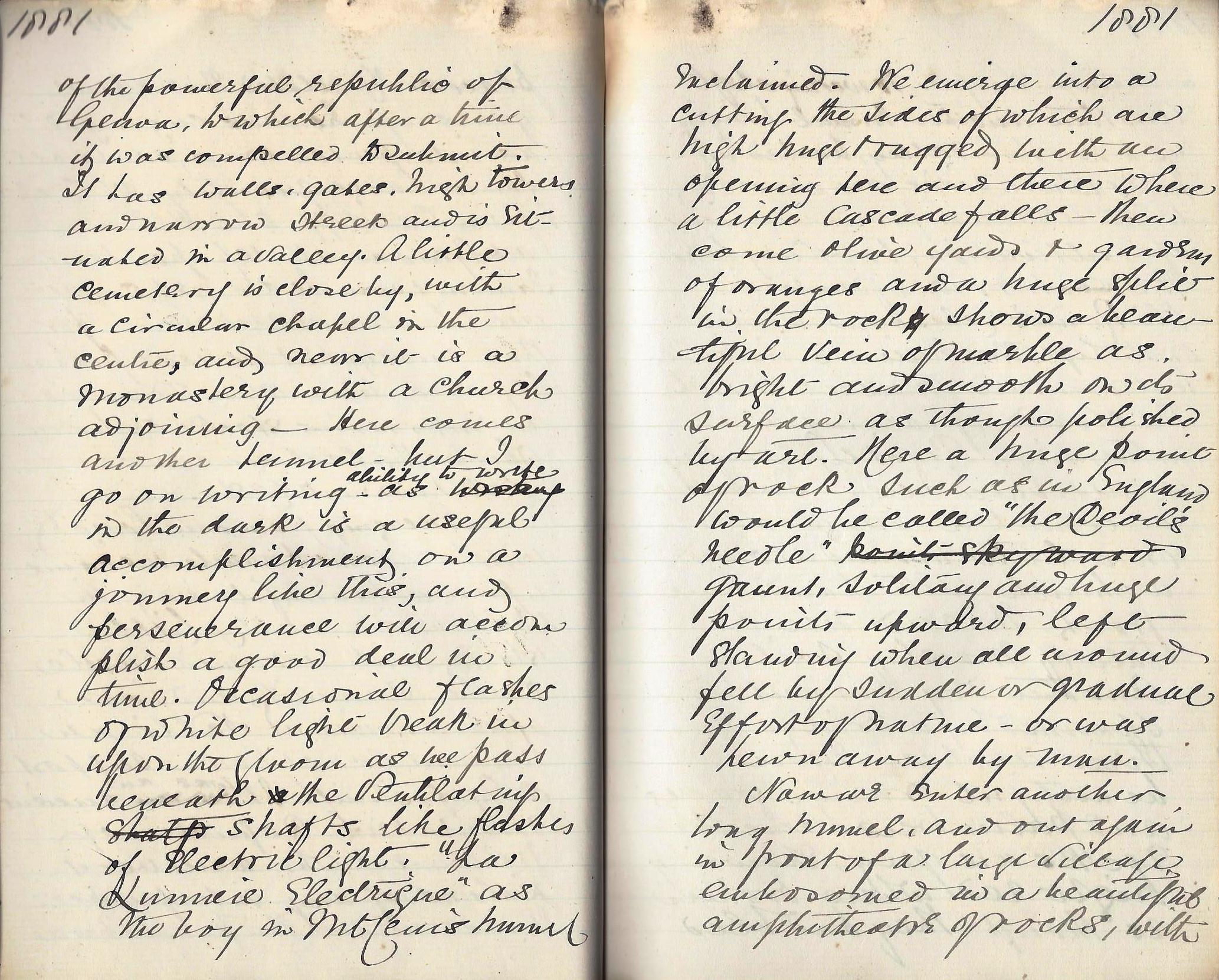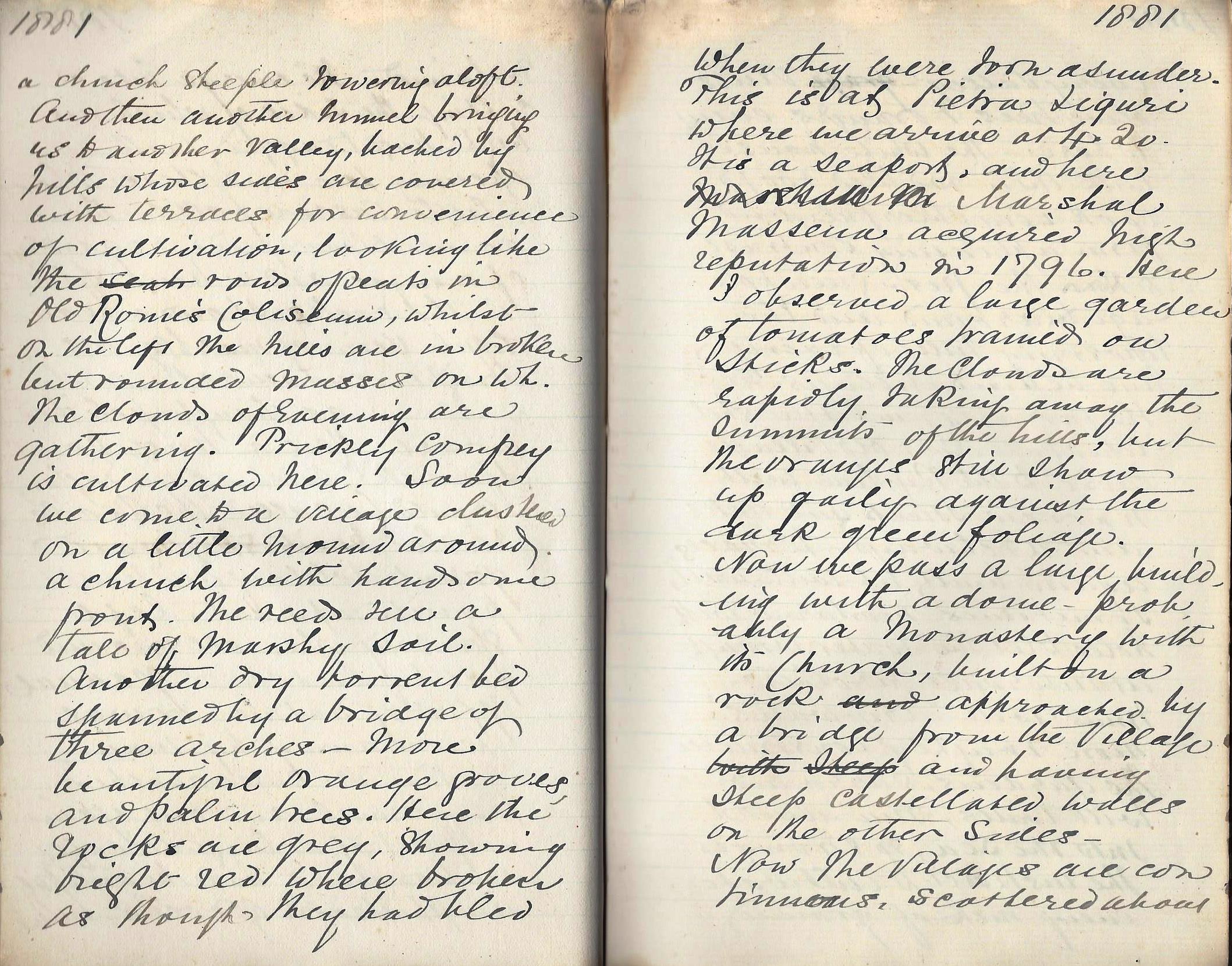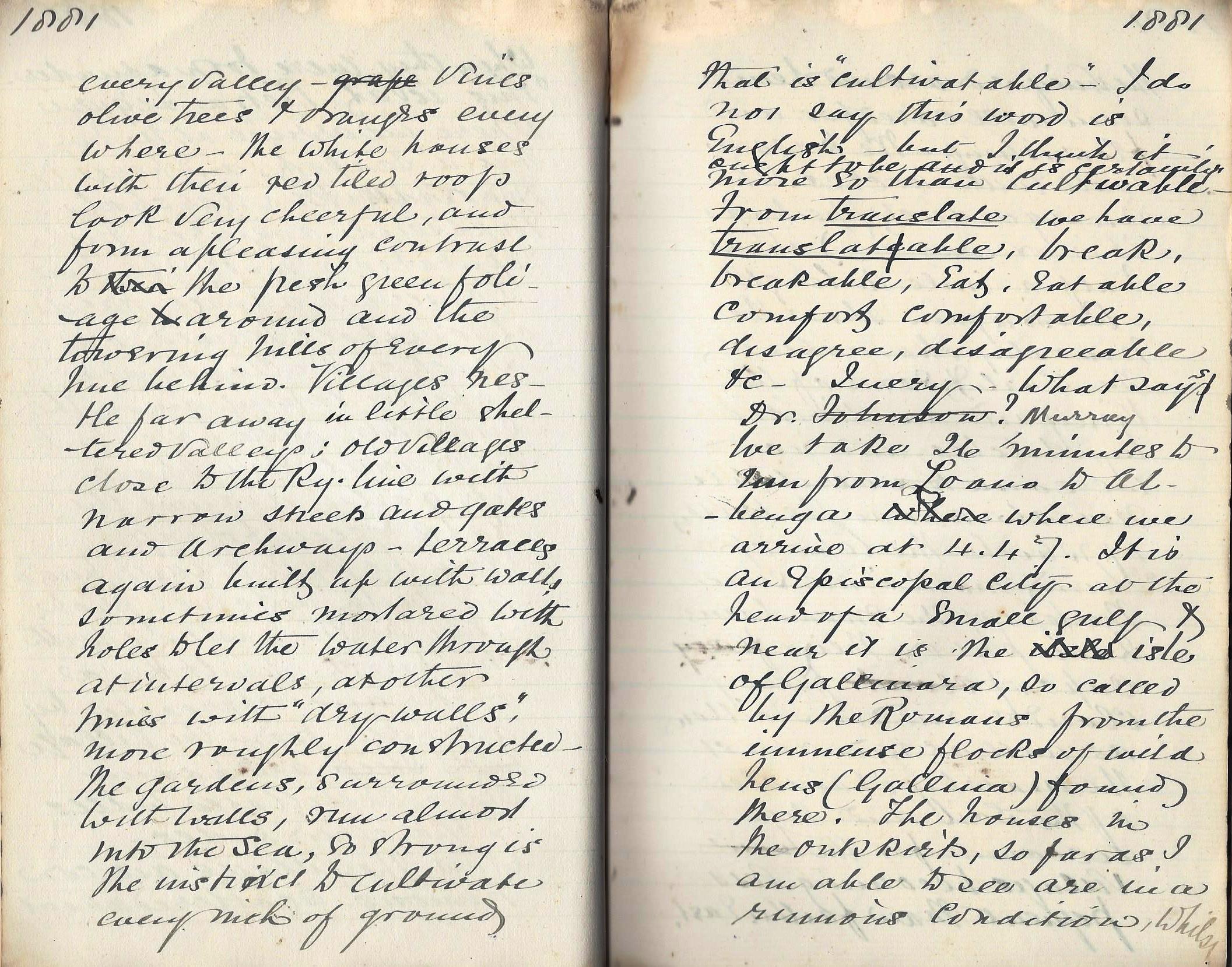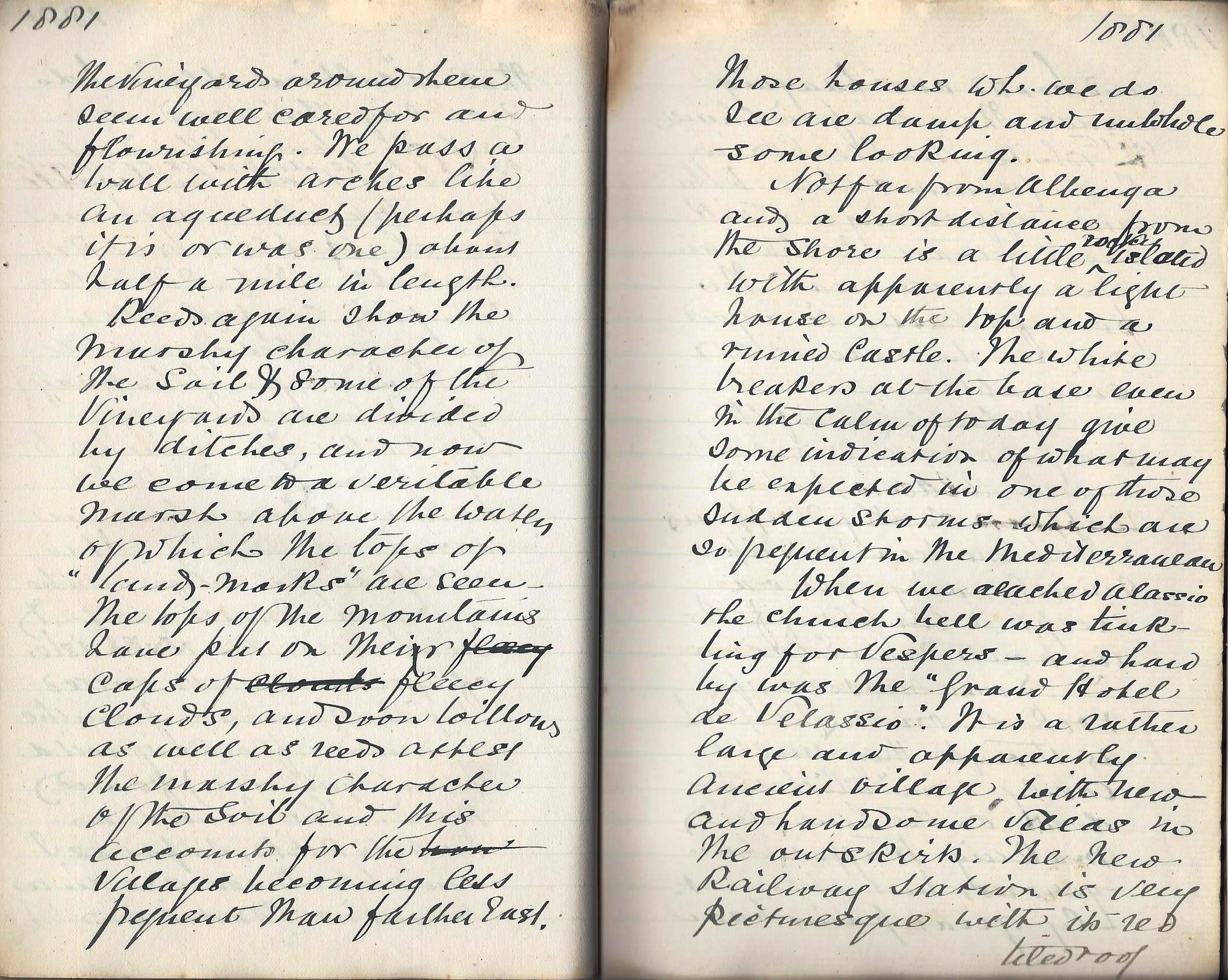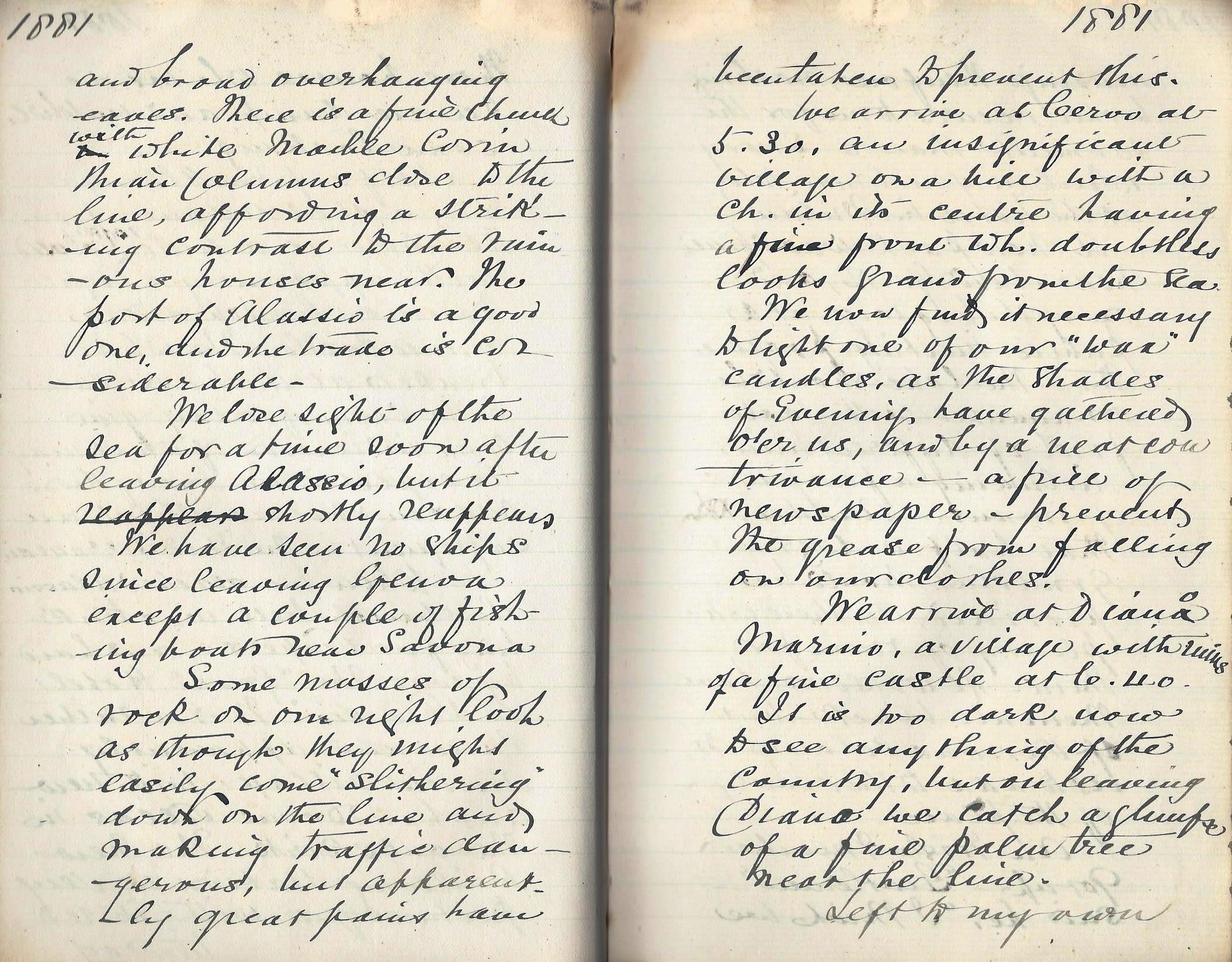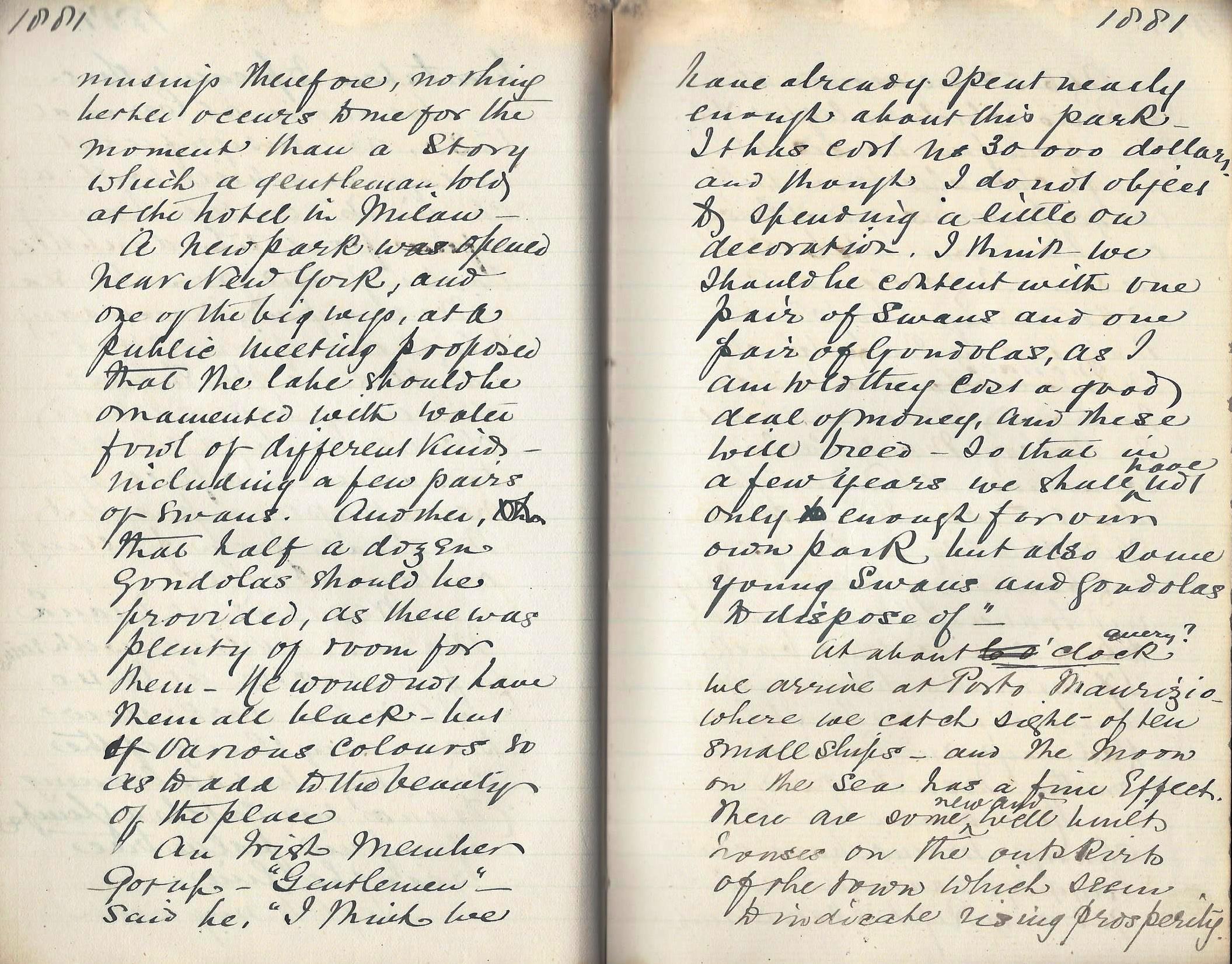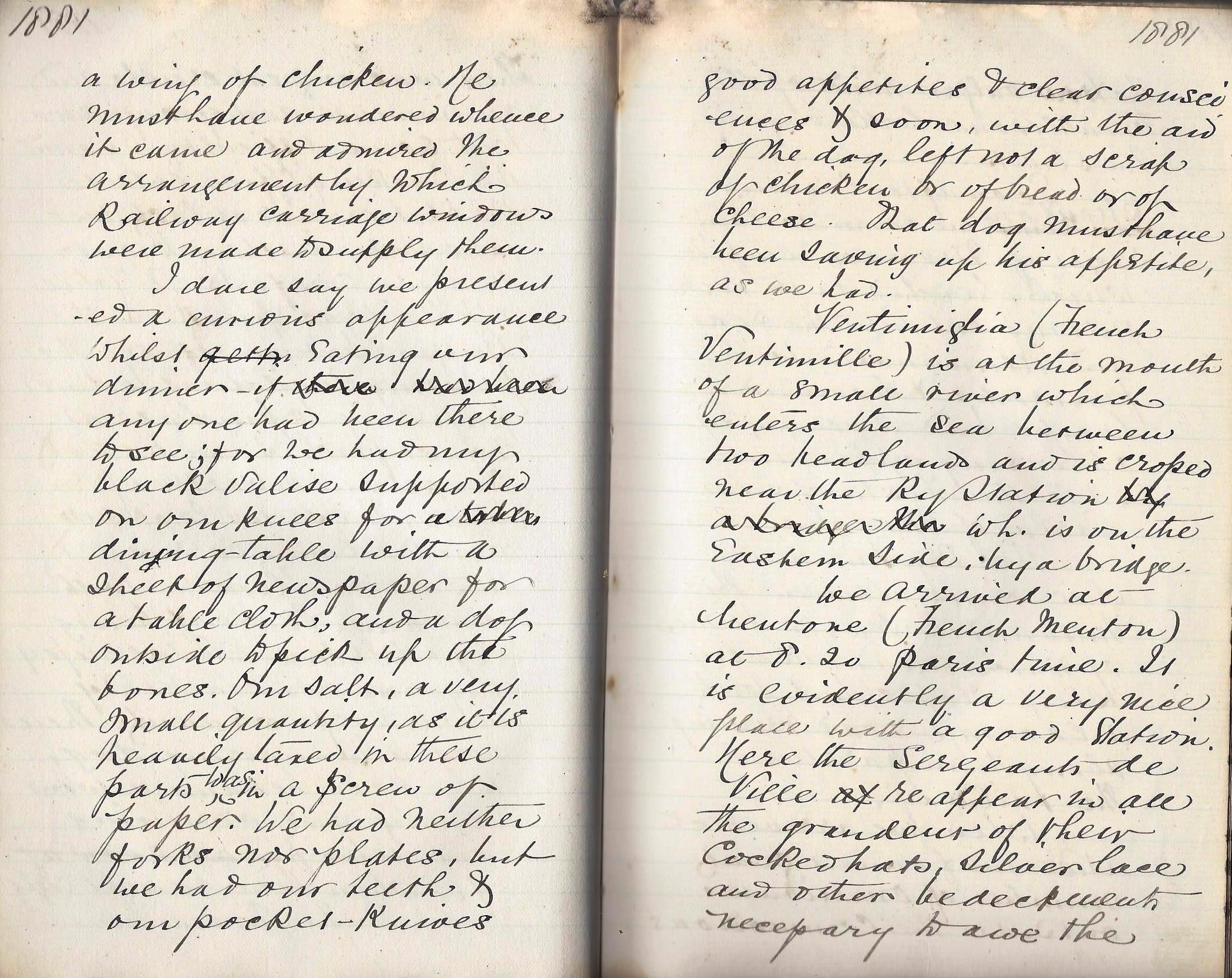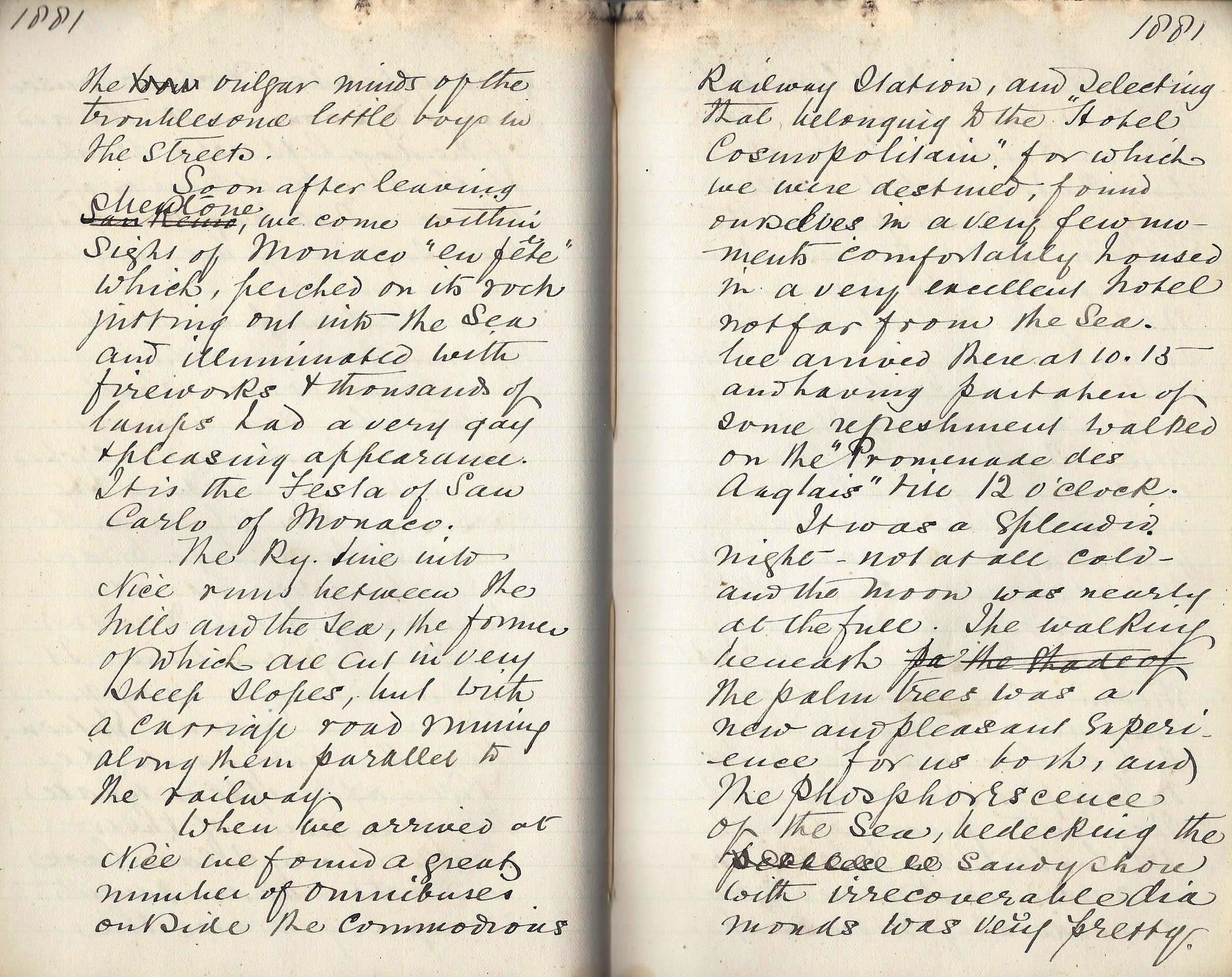1881, November 3, Thursday a b c d e f g h i j k l m n o p
I slept very well last night, lulled to sleep by the plashing of a fountain in the street outside my bedroom window – but a long way down.
After breakfast we sallied forth again and passing through very busy and very narrow streets came to the Cathedral of S. Lorenzo, the exterior of which is composed of alternate blocks of black and white marble. S. Lawrence on gridiron above the portail. Jesse tree on right and nativity on left. Here are said to be preserved the ashes of S. John the Baptist in two reliquaries or urns of silver gilt made in 1488. They are paraded through the streets of Genoa with much pomp on Corpus Christi day, and are said to have been brought from Myrrha a seaport town of Lycia. They have also the Catino or Emerald Vase, believed by the Genoese to be the dish on which Our Lord instituted the Last Supper, captured from the Saracens at the storming of Caesarea in 1101. They have also an ancient agate dish containing a representation of the head of John the Baptist said to have been the very “charger” on which the daughter of Herodias received the head of the murdered saint. There are some fine stained glass windows.
We purchased some books to read on our railway journey today and some candles to read them by when darkness should set in – and passed through some arcades near the harbour – which were evidently very old with shops on one side and occaisonly both. They were very unpleasant places, the air in them being close and foul and everything and everyone – excepting ourselves of course – presenting a very dirty and unwholesome appearance.
At the bottom of the street in which our hotel is situated Vere caught sight of a live animal shop, with parrots, monkeys, etc. We had seen it before and it was quite a landmark to us, as he knew it by sight, or smell, I am somewhat uncertain which, at a very considerable distance.
The day was very lovely – such as we should expect in July at home.
Returning to the Croix de Malte our omnibus, a good and commodious one soon took us to the handsome Railway Station, and at about 2 o’clock we started for Nice.
The Mediterranean looked more beautiful than we had yet seen it. It was of a deep blue and tranquil yet not dead, like the heaving bosom of a sleeping beauty with a pretty good will of her own. We passed many handsome villas one of which had a cascade falling over the chief entrance which looked like a curtain of diamonds glittering in the sun. There were numerous fountains and other cascades in the gardens fed by a mountain stream which we could see tumbling down in the rear.
We passed many orange gardens with trees heavily laden with fruit, some green, some pale yellow and others golden, whilst some trees were also in bloom.
Vere was reading a volume of Sir Walter Scott, and the frequency of the tunnels through which we passed afforded him a fine opportunity of considering well the beauties of one passage before going on to the next.
It would seem that the wind is sometimes very strong along this Eastern Western Riviera, for I observed numerous buildings with large stones (cemented?) on the roof to prevent the tiles being blown away.
We passed numerous vineyards and olive gardens in the former of which were frequently rows of rough stone pillars about 7 feet high, across the top of which strips of wood were fastened and to these the vines were trained forming in summer a delightful cool and shady walk with the luscious grapes hanging temptingly within a few inches of ones mouth. Sometimes these stone pillars were used as posts for fences, the remaining part being made of wood.
Rounding the gulf towards the west we had a beautiful view of Genoa across the calm blue waters of the Mediterranean, whilst on the other side were the rugged slopes of the maritime Alps clothed with firs and long grass wherever a hold for the roots of either could be obtained, and then would come a lovely dell, and then a deep gorge reft in the rocks giving clear indications of wild torrents in the Spring and Winter seasons. Then came larger valleys with white villages scattered about, each with its church towering above the meaner buildings – with here and there a monastery in the distance. Doubtless many of these villages would present a very squalid appearance if one were to find ones way into them, but “distance lends enchantment to the view” and the sun makes far off buildings, especially if they are large and white, look almost palatial.
Here and there we crossed the dry beds ov very considerable mountain torrents, in the infrequent pools of which women were busy washing their clothes.
In almost every garden is a well with the ancient lever above it for raising water for the purpose of irrigation.
At Celle station which is near the beach there was a number of urchins begging for coppers. I could not catch their words beyond “signori, signori” – but I threw them some coppers which buried themselves in the sand where they fell and immediately an amusing struggling, laughing heap composed of heads, arms, legs and tattered garments of various hues intermingled in various confusion was scrambling and kicking above the spot. The coins having presumably been recovered the same scene was repeated till the train moved on much to the regret of the youngsters, for although they ran to keep up with it in the hope of more coppers falling to their lot, they were soon left far behind.
Here and there the scene I observed between Genoa and Pisa was repeated with equally picturesque effect, long lines of fishermen and their wives and sisters and daughters engaged in hauling up their nets to the beach.
There are many huge conglomerate rocks along the land side of the line which carry one’s mind back to the time when those rounded pebbles and boulders were first broken by antediluvian disturbance from their parent mountains.
We passed several decaying and decayed villages with ruined churches which do not look at all picturesque, but are rather a blot upon the scene. It requires ivy to give beauty to a ruin, the contrast of youthful vigour with age and decay, of the shining green of the foliage with the dull gray of the stone. Then we entered another tunnel and the rumble rumble rumble of the train put a stop to conversation and the darkness and jolting to writing. Then we emerge into daylight again and the vineyards appear all the more beautiful and the mountains all the more green by contrast with the darkness just left.
At 3.10 we arrive at Savona a seaport of considerable size and importance. Here a young woman entered our carriage and, whilst I was standing inside looking out at the door, removed my bags and took my seat, though it was a carriage “pei fumatori.” I explained and asked her for my seat which she gave up and went to the opposite side of the carriage. Then I made room for her beside me with back to the engine by removing my bags and she said “thank you” in good English. Query did she see that we were English and so come into our carriage marked “pei fumatori” for the comfort of having fellow countrymen to talk to? She was accompanied by an elderly lady who conversed with her in French. However, I feel rather ashamed of myself for claiming my right to the seat though perhaps it was just as well she should be taught the “rule of the road” if she did not know it.
In the neighbourhood of Savona there are plenty of handsome villas on the slopes of the mountains – vineyards with watchmen’s houses – and here and there a Madonna over the gateway. More women and girls washing clothes in pools in beds of otherwise dry mountain torrents crossed by a bridge of a single arch – on the top of a distant hill a solitary looking monastery, the dwellers in which probably do all the work of the place and if so cannot lead such idle lives as we sometimes imagine. Doubtless the more work they do the pleasanter on the whole their lives are – for the man who works hard for 6 days in the week gets more pleasure out of his one day of rest than the lounger does out of the seven. To me when Sunday was my day of rest the leaves and grass were of a brighter green, the sun shone more cheerfully, the birds sang more sweetly, and the breeze was more refreshing than on any other day of the week. But this is more noticeable in towns than in the country as the contrast between the bustle and din of the Six days and the comparative quiet of the Sunday is more observable. Again we get a view of the sea with Savona in the distance at the head of its bay. The sea and the hills are alike blue, but the former is the deeper colour. (No pun intended.) Then we come to a very long tunnel through which we slowly crawl and in which we are almost stifled by the sulphurous vapours from the very bad coal consumed by our iron horse. Our guide at Turin told us that there was no good coal in Italy and consequently a large quantity is imported from Cardiff and other places. He related that a few years ago he was engaged as interpreter on a contract for a large quantity of coal from Cardiff to be delivered at Genoa at 10/- per ton. I am not sure he did not say it was to be delivered at Turin for that money; but it was probably at a time when there was an enormous stock on hand which the coalmasters wished to turn into cash.
Emerging from a long and unwholesome tunnel, we came upon a beautiful bay in which was a rocky little island with a ruined castle on the summit, and soon after arrived at Nolli an ancient coast town supported by fishing. It was an ancient miniature republic of fishermen who were very jealous of any interference. It was under the protection of the powerful republic of Genoa, to which after a time it was compelled to submit. It has walls, gates, high towers and narrow streets and is situated in a valley. A little cemetery is close by, with a circular chapel in the centre, and near it is a monastery with a church adjoining – Here comes another tunnel – but I go on writing – as ability to write in the dark is a useful accomplishment on a journey like this, and perseverance will accomplish a good deal in time.
(The handwriting deteriorates noticeably for the next couple of sentences.)
Occasional flashes of white light break in upon the gloom as we pass beneath the ventilating shafts like flashes of electric light. “La Lumiere Electrique” as the boy in Mt Cenis tunnel exclaimed. We emerge into a cutting the sides of which are high huge and rugged with an opening here and there where a little cascade falls – then come olive yards and gardens of oranges amd a huge split in the rock shows a beautiful vein of marble as bright and smooth on its surface as though polished by art. Here a huge point of rock such as in England would be called “the Devil’s needle” gaunt, solitary and huge points upward, left standing when all around fell by sudden or gradual effort of nature – or was hewn away by man.
Now we enter another long tunnel, and out again in front of a large village embosomed in a beautiful amphitheatre of rocks, with a church steeple towering aloft. And then another tunnel bringing us to another valley, backed by hills whose sides are covered with terraces for convenience of cultivation, looking like the rows of seats in Old Rome’s Coliseum, whilst on the left the hills are in broken but rounded masses on which the clouds of evening are gathering. Prickly comfrey is cultivated here. Soon we come to a village clustered on a little mound around a church with handsome front. The reeds tell a tale of marshy soil. Another dry torrent bed spanned by a bridge of three arches – more beautiful orange groves, and palm trees. Here the rocks are grey, showing bright red where broken as though they had bled when they were torn asunder. This is at Pietra Liguri where we arrive at 4.20. It is a seaport, and here Marshal Massena acquired high reputation in 1796. Here I observed a large garden of tomatoes trained on sticks. The clouds are rapidly taking away the summits of the hills, but the oranges still show up gaily against the dark green foliage. Now we pass a large building with a dome – probably a monastery with its Church, built on a rock and approached by a bridge from the village and having steep castellated walls on the other sides. Now the villages are continuous, scattered about every valley – vines, olive trees and oranges everywhere – the white houses with their red tiled roofs look very cheerful, and form a pleasing contrast to the fresh green foliage around and the towering hills of every hue behind. Villages nestle far away in little sheltered valleys; old villages close by to the Railway line with narrow streets and gates and archways – terraces again built up with walls sometimes mortared with holes to let the water through at intervals, at other times with “dry walls”, more roughly constructed – the gardens, surrounded with walls, run almost into the sea, so strong is the instinct to cultivate every inch of ground that is “cultivatable” – I do not say this word is English – but I think it ought to be and it is certainly more so than “cultivable” – from translate we have translatable, break, breakable, eat, eatable, comfort, comfortable, disagree, disagreeable etc. Query – What says Dr Johnson? Murray.
We take 26 minutes to run from Loano to Albenga where we arrive at 4.47. It is an Episcopal city at the head of a small gulf and near it is the isle of Gallinara, so called by the Romans from the immense flocks of wild hens (Gallina) found there. The houses in the outskirts, so far as I am able to see are in a ruinous condition, whilst the vineyards around here seem well cared for and flourishing. We pass a wall with arches like an aqueduct (perhaps it is or was one) about half a mile in length.
Reeds again show the marshy character of the soil and some of the vineyards are divided by ditches, and now we come to a veritable marsh above the waters of which the tops of “land-marks” are seen. The tops of the mountains have put on their caps of fleecy clouds, and soon willows as well as reeds attest the marshy character of the soil and this accounts for the villages becoming less frequent than farther east. Those houses which we do see are damp and unwholesome looking.
Nut far from Albenga and a short distance from the shore is a little rocky island with apparent;y a lighthouse on the top and a ruined castle. The white breakers at the base even in the calm of day give some indication of what may be expected in one of those sudden storms which are so frequent in the Mediterranean.
When we reached Alassio the church bell was tinkling for Vespers – and hard by was the “Grand Hotel de Velassio”. It is a rather large and apparently ancient village with new and handsome villas in the outskirts. The new Railway Station is very picturesque with its red tiled roof and broad overhanging eaves. There is a fine church with white marble Corinthian columns close to the line, affording a striking contrast to the ruinous houses near. The port of Alassio is a good one, and the trade is considerable.
We lose sight of the sea for a time soon after leaving Alassio, but it shortly reappears. We have seen no ships since leaving Genoa except a couple of fishing boats near Savona.
Some masses of rock on our right look as though they might easily come “slithering” down on the line and making traffic dangerous, but apparently great pains have been taken to prevent this.
We arrive at Cervo at 5.30, an insignificant village on a hill with a church in its centre having a fine front which doubtless looks grand from the sea.
We now find it necessary to light one of our “wax” candles, as the shades of evening have gathered o’er us, and by a neat contrivance – a piece of newspaper – prevent the grease from falling on our clothes.
We arrive at Diano Marino, a village with ruins of a fine castle at 6.40.
It is too dark now to see anything of the country, but on leaving Diano we catch a glimpse of a fine palm tree near the line.
Left to my own musings therefore, nothing better occurs to me for the moment than a story which a gentleman told at the hotel in Milan.
A new park was opened near New York, and one of the big wigs, at a public meeting proposed that the lake should be ornamented with water fowl of different kinds – including a few pairs of swans. Another, that half a dozen gondolas should be provided, as there was plenty of room for them – he would not have them all black but of various colours so as to add to the beauty of the place.
An Irish member got up – “Gentlemen” – said he, “I think we have already spent nearly enough about this park. It has cost us 30 000 dollars and though I do not object to spending a little on decoration, I think we should be content with one pair of swans and one pair of gondolas, as I am told they cost a good deal of money, and these will breed – so that in a few years we shall have not only enough for our own park but also some young swans and gondolas to dispose of.”
At about 6 o‘clock (query?) we arrive at Porto Maurizio, where we catch sight of ten small ships – and the moon on the sea has a fine effect. There are some new and well built houses on the outskirts of the town which seem to indicate rising prosperity.
At 6.53 we arrived at San Remo which we left at 7.5. There some fine houses in this fashionable town with large pensions and at least one handsome hotel which we saw. A gentleman entered the carriage who told me that today the “festa” of Monaco was being held and tomorrow would be that of Monte Carlo. We arrived at Ventimiglia about 7.30. It is a small episcopal city on the present boundary between Italy and France. here we had to put our watches back 47 minutes, Roman time being kept on the Italian Railways and Paris time on the French ones.
Here we had to change trains, have our luggage examined and get our Railway tickets stamped. There was a great crush and an immediate deal of confusion. With some difficulty I found the Booking Office outside the Station and at last we were ready to attend to our creature comforts. A “table d’hôte” was spread in the “Buffet” but we refused the pressing invitations to dine, preferring to purchase a roast fowl, some bread and cheese and a bottle of wine, these we took into our railway carriage and ate at our leisure without any fear of being left behind whilst enjoying our considerably needed refreshment. There was a wandering dog, who soon became a wondering and admiring one for when Vere caught sight of him he threw him a wing of chicken. He must have wondered whence it came and admired the arrangement by which Railway carriage windows were made to supply them.
I dare say we presented a curious appearance whilst eating our dinner – if anyone had been there to see; for we had my black valise supported on our knees for a dining-table with a sheet of newspaper for a table cloth, and a fog outside to pick up the bones. Our salt, a very small quantity, as it is heavily taxed in these parts was in a screw of paper. We had neither forks nor plates, but we had our teeth and our pocket-knives, good appetites and clear consciences and soon with the aid of the dog, left not a scrap of chicken or of bread or of cheese. That dog must have been saving up his appetite, as we had.
Ventimiglia (French Ventimille) is at the mouth of a small river which enters the sea between two headlands and is crossed near the Railway Station which is on the Eastern side, by a bridge.
We arrived at Mentone (French Menton) at 8.20 Paris time. It is evidently a very nice place with a good station. here the Sergeants de Ville reappear in all the grandeur of their cocked hats, silver lace and other bedeckments necessary to awe the vulgar minds of the troublesome little boys in the streets.
Soon after leaving Mentone we come within sight of Monaco “en fête” which, perched on its rock jutting out into the sea and illuminated with fireworks and thousands of lamps had a very gay and pleasing appearance. It is the Festa of San Carlo of Monaco.
The Railway Line into Nice runs between the hills and the sea, the former of which are cut in very steep slopes, but with a carriage road running along them parallel to the railway.
When we arrived at Nice we found a great number of omnibuses outside the commodious Railway Station, and selecting that belonging to the “Hotel Cosmopolitain” for which we were destined, found ourselves in a very few moments comfortably housed in a very excellent hotel not far from the sea. We arrived there at 10.15 and having partaken of some refreshment walked on the “Promenade des Anglais” till 12 o’clock.
It was a splendid night – not at all cold – and the moon was nearly at the full. The walking beneath the palm trees was a new and pleasant experience for us both, and the phosphorescence of the sea, bedecking the sandy shore with irrecoverable diamonds was very pretty.

